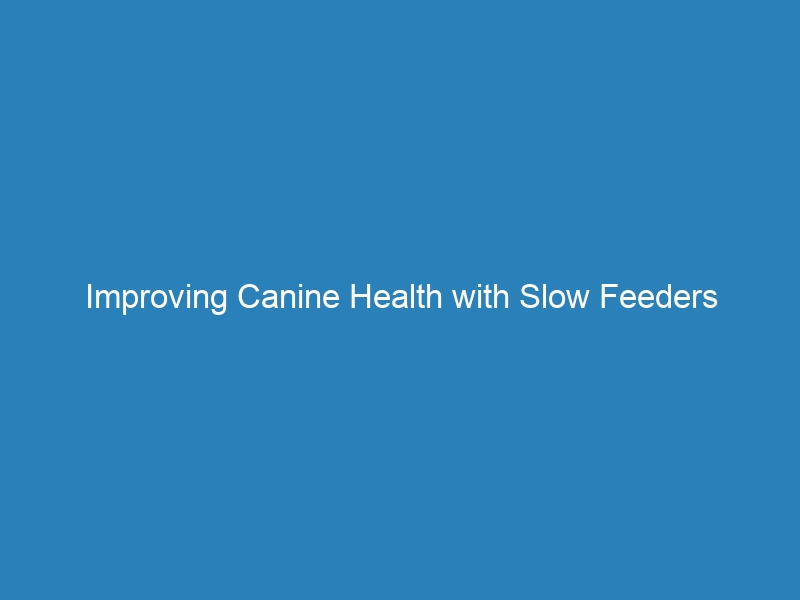Improving Canine Health with Slow Feeders

Slow feeders have gained popularity among dog owners as a tool to promote healthier eating habits and improve canine well-being. These specialized bowls are designed to reduce a dog’s eating speed, offering several benefits for their physical and mental health. By encouraging slower eating, these feeders can help prevent issues such as bloat, obesity, and digestive problems.
They also provide mental stimulation for dogs, as the animals must work harder to access their food, potentially reducing boredom and anxiety. A primary advantage of slow feeders is their ability to prevent rapid eating, which can lead to various health issues in dogs. When dogs eat too quickly, they often swallow air along with their food, potentially causing bloating and more serious conditions like gastric torsion.
Slow feeders help mitigate these risks by promoting a more measured eating pace, which can improve digestion. Additionally, these feeders can be effective in managing canine obesity by helping dogs feel satiated for longer periods and preventing overeating. Incorporating a slow feeder into a dog’s feeding routine can thus have a positive impact on their overall health and well-being.
Key Takeaways
- Slow feeders can help improve canine digestion and prevent overeating
- They can also prevent bloat and gastric torsion in dogs, which can be life-threatening
- Using slow feeders can help manage canine obesity and promote a healthier weight
- Introducing your dog to a slow feeder may require patience and positive reinforcement
- There are different types of slow feeders available, so it’s important to choose the right one for your dog’s specific needs
How Slow Feeders Can Prevent Bloat and Gastric Torsion in Dogs
How Slow Feeders Can Help Prevent Bloat
The use of slow feeders can help prevent bloat and gastric torsion in dogs by slowing down their eating pace and reducing the amount of air they swallow while eating. When dogs eat too quickly, they are more likely to gulp air along with their food, which can contribute to the development of bloat. Slow feeders are designed with obstacles or patterns that make it more difficult for dogs to access their food quickly, forcing them to take smaller bites and chew more thoroughly.
The Benefits of Slow Feeders
This not only helps prevent the ingestion of excess air but also promotes better digestion. By incorporating a slow feeder into a dog’s feeding routine, pet owners can significantly reduce the risk of bloat and gastric torsion, ultimately promoting better digestive health and overall well-being for their canine companions.
Promoting Better Digestive Health
By using slow feeders, pet owners can take a proactive approach to preventing bloat and promoting better digestive health in their dogs. This simple change to their feeding routine can have a significant impact on their dog’s overall health and well-being.
Using Slow Feeders to Manage Canine Obesity and Overeating
Obesity is a common issue among dogs, with an estimated 56% of dogs in the United States being classified as overweight or obese. Just like in humans, obesity in dogs can lead to a range of health problems, including diabetes, arthritis, and heart disease. Slow feeders can be an effective tool for managing canine obesity and preventing overeating by encouraging dogs to eat at a slower pace and feel fuller for longer periods of time.
By slowing down their eating pace, dogs are less likely to consume excess calories and are more likely to feel satisfied with smaller portions of food. In addition to promoting healthy weight management, slow feeders can also provide mental stimulation for dogs, as they have to work a little harder to access their food. This can help alleviate boredom and reduce anxiety in dogs, ultimately contributing to their overall well-being.
Furthermore, using a slow feeder can help improve a dog’s relationship with food by encouraging them to eat mindfully and savor their meals. By incorporating a slow feeder into a dog’s feeding routine, pet owners can help their canine companions maintain a healthy weight and develop better eating habits.
Improving Digestive Health with Slow Feeders
| Slow Feeder Type | Effectiveness | Cost |
|---|---|---|
| Maze-style slow feeder | High | Medium |
| Puzzle ball slow feeder | Medium | Low |
| Hay net slow feeder | Low | Low |
Digestive issues such as indigestion, vomiting, and diarrhea are common problems that many dogs experience. These issues can be caused by a variety of factors, including eating too quickly and swallowing air while eating. Slow feeders can help improve digestive health in dogs by encouraging them to eat at a slower pace and chew their food more thoroughly.
By slowing down their eating pace, dogs are less likely to experience indigestion and other digestive problems associated with rapid eating. Furthermore, slow feeders can also help prevent vomiting and regurgitation in dogs by reducing the likelihood of overeating and gulping air while eating. The design of slow feeders often includes obstacles or patterns that make it more difficult for dogs to access their food quickly, forcing them to take smaller bites and chew more thoroughly.
This not only promotes better digestion but also helps prevent issues such as vomiting and regurgitation. By incorporating a slow feeder into a dog’s feeding routine, pet owners can help improve their digestive health and overall well-being.
Training Tips for Introducing Your Dog to a Slow Feeder
Introducing a slow feeder to your dog’s feeding routine may require some patience and training, especially if your dog is used to eating quickly from a traditional bowl. To help your dog adjust to using a slow feeder, it’s important to start by choosing the right type of slow feeder that suits your dog’s needs and preferences. Once you have selected a slow feeder, gradually introduce it to your dog by placing it next to their regular feeding bowl during meal times.
Allow your dog to investigate the slow feeder at their own pace without any pressure. Once your dog is comfortable with the presence of the slow feeder, you can start incorporating it into their feeding routine by adding a small amount of food to the slow feeder along with their regular portion of food in their regular bowl. This will allow your dog to become familiar with the new feeding method without feeling overwhelmed.
Over time, gradually increase the amount of food in the slow feeder while reducing the amount in their regular bowl until your dog is fully transitioned to using the slow feeder. It’s important to be patient and consistent during this process, as some dogs may take longer to adjust to using a slow feeder than others.
Different Types of Slow Feeders and Their Effectiveness
Maze or Puzzle Feeders
One common type of slow feeder is the maze or puzzle feeder, which features obstacles or patterns that make it more difficult for dogs to access their food quickly. These feeders encourage dogs to take smaller bites and chew more thoroughly, ultimately slowing down their eating pace.
Raised or Elevated Feeders
Another type of slow feeder is the raised or elevated feeder, which requires dogs to reach up for their food, slowing down their eating pace and promoting better posture during meal times.
Slow Feeders for Wet or Raw Food Diets
Additionally, there are slow feeders designed specifically for wet or raw food diets, such as silicone mats with ridges or patterns that require dogs to lick or nuzzle their food out slowly. These feeders can be particularly effective for dogs who tend to eat too quickly when given wet or raw food.
Choosing the Right Slow Feeder
When choosing a slow feeder for your dog, it’s important to consider their individual needs and preferences, as well as the specific issues you are trying to address. By selecting the right type of slow feeder for your dog, you can effectively promote healthier eating habits and improve their overall well-being.
Tips for Choosing the Right Slow Feeder for Your Dog’s Needs
When choosing a slow feeder for your dog, it’s important to consider their individual needs and preferences in order to select the most effective option. Start by assessing your dog’s eating habits and any specific issues you are trying to address with a slow feeder, such as rapid eating or overeating. If your dog tends to eat too quickly, a maze or puzzle feeder with various obstacles or patterns may be the most effective option for slowing down their eating pace.
For dogs who are prone to overeating or gulping air while eating, a raised or elevated feeder may be more suitable as it encourages them to eat at a slower pace and promotes better posture during meal times. Additionally, if your dog is on a wet or raw food diet, consider choosing a slow feeder specifically designed for these types of diets, such as silicone mats with ridges or patterns that require dogs to lick or nuzzle their food out slowly. It’s also important to consider the size and durability of the slow feeder, especially if you have a larger or more energetic dog.
Ultimately, choosing the right slow feeder for your dog’s needs will depend on their individual habits and preferences, as well as any specific issues you are trying to address. By selecting the most suitable option for your dog, you can effectively promote healthier eating habits and improve their overall well-being.
If you’re looking for ways to improve your dog’s eating habits, you may want to consider using a slow feeder. These specialized bowls can help prevent your pup from eating too quickly, which can lead to digestive issues and obesity. For more information on how to choose the right slow feeder for your dog, check out this helpful article on different types of slow feeders available.
FAQs
What is a slow feeder for dogs?
A slow feeder for dogs is a specially designed bowl or feeding device that is used to slow down a dog’s eating pace. It typically has obstacles or ridges that require the dog to work around in order to access their food, which helps to prevent them from eating too quickly.
Why is it important for dogs to eat slowly?
Eating too quickly can lead to a variety of health issues for dogs, including choking, vomiting, and gastrointestinal discomfort. Slow feeders help to promote healthier eating habits and can also prevent conditions such as bloat, which can be life-threatening for dogs.
What are the benefits of using a slow feeder for dogs?
Using a slow feeder can help to improve digestion, reduce the risk of bloat, and prevent obesity in dogs. It can also provide mental stimulation and enrichment during meal times, as the dog has to work to access their food.
How do I choose the right slow feeder for my dog?
When choosing a slow feeder for your dog, consider their size, eating habits, and any specific health concerns they may have. Look for a feeder that is appropriately sized for your dog and has features that will challenge them without causing frustration.
Are there any dogs that should not use a slow feeder?
While slow feeders can be beneficial for many dogs, they may not be suitable for dogs with certain medical conditions, such as megaesophagus or dental issues. It’s important to consult with a veterinarian before using a slow feeder if your dog has any health concerns.


Recent Comments